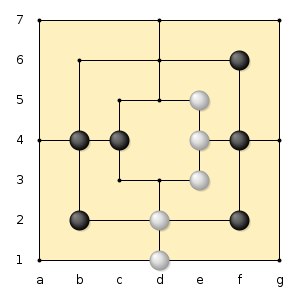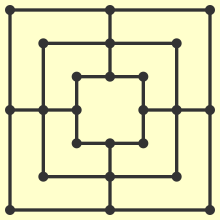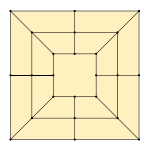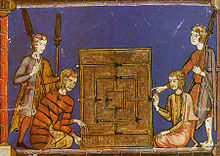- Nine Men's Morris
-
Nine Men's Morris is an abstract strategy board game for two players that emerged from the Roman Empire.[1] The game is also known as Nine Man Morris, Mill, Mills, Merels, Merelles, and Merrills in English.
Three Men's Morris, Six Men's Morris and Twelve Men's Morris are similar games; see below.
Contents
Rules of play
Each player has nine pieces, or "men", which move among the board's twenty-four spots. The object of the game is to leave the opposing player with fewer than three pieces or, as in checkers, no legal moves.
Placing the pieces
The game begins with an empty board. Players take turns placing their pieces on empty spots. If a player is able to form a straight row of three pieces along one of the board's lines (i.e. not diagonally), he has a "mill" and may remove one of his opponent's pieces from the board; removed pieces may not be placed again. Players must remove any other pieces first before removing a piece from a formed mill. Once all eighteen pieces have been used, players take turns moving.
Moving the pieces
To move, a player slides one of his pieces along a board line to an empty adjacent spot. If he cannot do so, he has lost the game.
As in the placement stage, a player who aligns three of his pieces on a board line has a mill and may remove one of his opponent's pieces, avoiding the removal of pieces in mills if at all possible.
Any player reduced to two pieces is unable to remove any more opposing pieces and thus loses the game.
Flying
In one common variation, once a player is reduced to three pieces, his pieces may "fly", "hop"[2][3] or "jump"[4] to any empty spots, not only adjacent ones. Some sources of the rules say this is the way the game is played,[3][4] some treat it as a variation,[2][5][6][7] and some don't mention it at all.[8] A '19th Century Games Manual' calls this the "truly rustic mode of playing the game".[2]
Strategy
At the beginning of the game, it is more important to place pieces in versatile locations rather than to try to form mills immediately and make the mistake of concentrating one's pieces in one area of the board.[9]
An ideal position, which typically results in a win, is to be able to shuttle one piece back and forth between two mills, removing a piece every turn. For example, in the diagram above, white can win the game even if black moves first.
Variants
Six Men's Morris
Six Men's Morris gives each player six pieces and is played without the outer square found on the board of Nine Men's Morris. Flying is not allowed.[10] It was popular in Italy, France and England during the Middle Ages but was obsolete by 1600.[10] This board is also used for Five Men's Morris. Seven Men's Morris uses this board with a cross in the center. Twelve Men's Morris
Twelve Men's Morris adds four diagonal lines to the board and gives each player twelve pieces. This means the board can be filled in the placement stage; if this happens the game is a draw. This variation on the game is popular amongst rural youth in South Africa where it is known as Morabaraba and is now recognized as a sport in that country. The same board is also used for Eleven Men's Morris. History
 Clay tile fragment from the archeological museum at Mycenae showing what appears to be a Nine Men's Morris board.
Clay tile fragment from the archeological museum at Mycenae showing what appears to be a Nine Men's Morris board.
According to R. C. Bell, the earliest known board for the game includes diagonal lines and was "cut into the roofing slabs of the temple at Kurna in Egypt" c. 1400 BCE.[10] However, Friedrich Berger writes that some of the diagrams at Kurna include Coptic crosses, making it "doubtful" that the diagrams date to 1400 BCE. Berger concludes, "certainly they cannot be dated."[1]
One of the earliest mentions of the game may be in Ovid's Ars Amatoria.[1][10] In book III (c. 8 CE), after discussing Latrones, a popular board game, Ovid wrote:
- There is another game divided into as many parts as there are months in the year. A table has three pieces on either side; the winner must get all the pieces in a straight line. It is a bad thing for a woman not to know how to play, for love often comes into being during play.
Berger believes the game was "probably well known by the Romans", as there are many boards on Roman buildings, even though dating them is impossible because the buildings "have been easily accessible" since they were built. It is possible that the Romans were introduced to the game via trade routes, but this cannot be proven.[1]
The game peaked in popularity in medieval England.[2] Boards have been found carved into the cloister seats at the English cathedrals at Canterbury, Gloucester, Norwich, Salisbury and Westminster Abbey.[10] These boards used holes, not lines, to represent the nine spaces on the board — hence the name "nine holes" — and forming a diagonal row did not win the game.[11] Another board is carved into the base of a pillar in Chester Cathedral in Chester.[12]
In Shakespeare's 16th century work A Midsummer Night's Dream, Titania laments that it is no longer played: "The nine men's morris is filled up with mud" (A Midsummer Night's Dream, Act II, Scene I).
Some authors say the game's origin is uncertain.[2] It has been speculated that its name may be related to Morris dances, and hence to Moorish, but according to Daniel King, "the word 'morris' has nothing to do with the old English dance of the same name. It comes from the Latin word merellus, which means a counter or gaming piece."[8] King also notes that the game was popular among Roman soldiers.
In some European countries, the design of the board was given special significance as a symbol of protection from evil,[1] and "to the ancient Celts, the Morris Square was sacred: at the center lay the holy Mill or Cauldron, a symbol of regeneration; and emanating out from it, the four cardinal directions, the four elements and the four winds."[2]
Related games
- Achi, from Ghana, is played on a Three Men's Morris board with diagonals. Each player has four pieces, which can only move to adjacent spaces.[13]
- Kensington is a similar game in which two players take turns placing pieces and try to arrange them in certain ways.
- Luk Tsut K'i ("Six Man Chess") in Canton and Tapatan in the Philippines are equivalent to Three Men's Morris played on a board with diagonals.[14]
- Morabaraba, equivalent to Twelve Men's Morris. However, rather than men, the counters are called "cows." It is still played competitively internationally in competitions run by the International Wargames Federation.
- Shax is played on the board of Nine Men's Morris, but with somewhat different rules and with twelve pieces per player instead of nine.
- Square chess is played on a seven-by-seven grid. Players move pieces one point at a time along the grid, attempting to form four-by-four squares and removing one of the opponent's pieces after forming a square. It is played in northwest China and Xinjiang.
- Tic-tac-toe uses a three-by-three board, on which players place pieces (or make marks) in turn until one player wins by forming an orthogonal or diagonal line or until the board is full and the game is drawn.
References
- ^ a b c d e Berger, Friedrich (2004). "From circle and square to the image of the world: a possible interpretation for some petroglyphs of merels boards" (PDF). Rock Art Research 21 (1): 11–25. http://mc2.vicnet.net.au/home/aura/shared_files/Berger1.pdf. Retrieved 2007-01-12.
- ^ a b c d e f Mohr, Merilyn Simonds (1997). The New Games Treasury. Houghton Mifflin. pp. 30–32. ISBN 1-57630-058-7.
- ^ a b Wood, Clement; Gloria Goddard (1940). The Complete Book of Games. Garden City, New York: Garden City Books. pp. 342–343.
- ^ a b Foster, R. F. (1946). Foster's Complete Hoyle: An Encyclopedia of Games. J. B. Lippincott Company. pp. 568–569.
- ^ Ainslie, Tom (2003). Ainslie's Complete Hoyle. Barnes & Noble Books. pp. 404–406. ISBN 0-7607-4159-X.
- ^ Morehead, Albert H.; Richard L. Frey, Geoffrey Mott-Smith (1956). The New Complete Hoyle. Garden City, New York: Garden City Books. pp. 647–649.
- ^ Grunfeld, Frederic V. (1975). Games of the World. Holt, Rinehart and Winston. pp. 59–61. ISBN 0-03-015261-5.
- ^ a b King, Daniel (2003). Games. Kingfisher plc. pp. 10–11. ISBN 0-7534-0816-3.
- ^ Vedar, Erwin A.; Wei Tu, Elmer Lee. "Nine Men's Morris". GamesCrafters. University of California, Berkeley. http://gamescrafters.berkeley.edu/games.php?game=ninemensmorris. Retrieved 2006-12-31.
- ^ a b c d e Bell, R. C. (1979). Board and Table Games from Many Civilizations, volume 1. New York City: Dover Publications. pp. 90–92. ISBN 0-486-23855-5.
- ^ "Nine Holes". Row Games. Elliott Avedon Museum and Archive of Games. 2005-09-12. http://www.gamesmuseum.uwaterloo.ca/VirtualExhibits/rowgames/nineholes.html. Retrieved 2007-01-09.
- ^ Hickey, Julia (2005). "The Hidden Treasures of Chester Cathedral". TimeTravel-Britain.com. http://www.timetravel-britain.com/05/fall/cathedral.shtml. Retrieved 2007-01-13.
- ^ Bell, R. C. (1979). Board and Table Games from Many Civilizations, volume 2. New York City: Dover Publications. pp. 55–56. ISBN 0-486-23855-5.
- ^ Culin, Stewart (October–December 1900). "Philippine Games" (PDF). American Anthropologist, New Series 2 (4): 643–656. doi:10.1525/aa.1900.2.4.02a00040. JSTOR 659313.
This game is also known as "Cowboy Checkers" and was once printed on the back of checkerboards.
External links
Where to play online
- Paul Emory Sullivan's Nine Men's Morris, an online program available in English, French and German and levels of game play from "beginner" to "guru"
- Nine Men's Morris applet by Leif Bennett
- Mills, a social game on Facebook by Aurel Gava
Similar games
Categories:- Abstract strategy games
- Traditional board games
Wikimedia Foundation. 2010.






